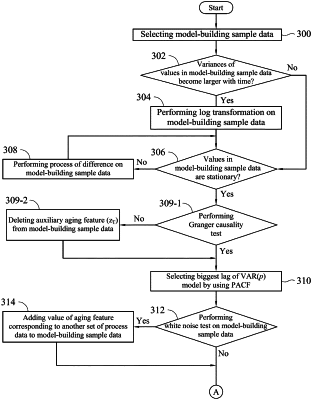| CPC G05B 23/0283 (2013.01) [G05B 23/024 (2013.01); G05B 23/0294 (2013.01)] | 18 Claims |

|
1. A multiple-variable predictive maintenance method, comprising:
obtaining a plurality of sets of process data used or generated by a component of a production tool when a plurality of workpieces are processed in sequence, wherein each of the sets of process data comprises values of a plurality of parameters, the values of each of the parameters in each of the sets of process data is a set of time series data values within a period of processing time when the component of the production tool is processing one of the workpieces, and the sets of process data are one-to-one corresponding to the sets of workpieces;
according to if an abnormal event occurs when the component is processing each of the workpieces, obtaining a plurality of event indicative values that are one-to-one corresponding to the sets of process data;
converting the set of time series data values of each of the parameters in each of the sets of process data to a value of a parameter indicator by using a plurality of algorithms respectively, wherein the parameter indicators are one-to-one corresponding to the parameters;
conducting a correlation analysis between each of parameter indicators and the event indicative values, thereby obtaining a plurality of correlation coefficients one-to-one corresponding to the parameter indicators;
selecting one of the parameter indicators that is corresponding to a maximum one of the correlation coefficients as an aging feature, and setting an auxiliary aging feature, wherein the auxiliary aging feature is another of the parameter indicators and is not corresponding to the maximum one of the correlation coefficients;
performing a first determination operation to determine if one of the workpieces is set as a sample selection point according to the value of the aging feature corresponding to each of the workpieces when processing the one of the workpieces;
performing a multiple-variable model-building operation, wherein the multiple-variable model-building operation comprises:
using N values of the aging feature and N values of the auxiliary aging feature as a set of model-building sample data, wherein the N values of the aging feature are corresponding to N sets of the sets of process data belonging to successive N of the workpieces that are processed directly before the sample selection point, wherein N is a positive integer;
performing a Granger causality test on the aging feature and the auxiliary aging feature to determine a correlation between the aging feature and the auxiliary aging feature, wherein if there is no correlation between the aging feature and the auxiliary aging feature, deleting the auxiliary aging feature from the set of model-building sample data;
building an aging-feature prediction model by using the set of model-building sample data in accordance a multiple-variable time series prediction algorithm, thereby obtaining a plurality of predicted values of the aging feature that are arranged in a processing order;
obtaining a plurality of time points at which the component processes the workpieces respectively in accordance with a plurality of process times used by the component for processing the workpieces respectively;
obtaining a dead spec that is a value of the aging feature used or generated by the component when the component cannot work; and
sequentially determining if the predicted values are substantially equal to the dead spec until an earliest one of the predicted values is found, wherein one of the time points corresponding to the earliest one is a death time point at which the component cannot work.
|